Business Economics Report: Tesco's Operations and Market Analysis
VerifiedAdded on 2020/02/12
|15
|4920
|139
Report
AI Summary
This report provides a comprehensive analysis of the business economics principles applied to Tesco, a leading UK retailer. It begins by examining fundamental economic concepts like scarcity, resource allocation, and the interplay of supply and demand. The report then delves into various market systems, including perfect competition, monopoly, monopolistic competition, and oligopoly, analyzing their impact on pricing strategies. It explores the role of opportunity costs and the significance of demand elasticity in market interactions. The analysis further extends to the implications of pricing strategies, corporate objectives, and the influence of different market structures on firm behavior. The report also investigates the impact of UK regulations on market power. Additionally, it covers macroeconomic policy tools and the effects of global economic factors, such as comparative advantage and free trade, on Tesco's operations, including the impact of emerging economies and economic shocks. The report concludes with an evaluation of the company's overall economic performance.

Business Economics
Paraphrase This Document
Need a fresh take? Get an instant paraphrase of this document with our AI Paraphraser
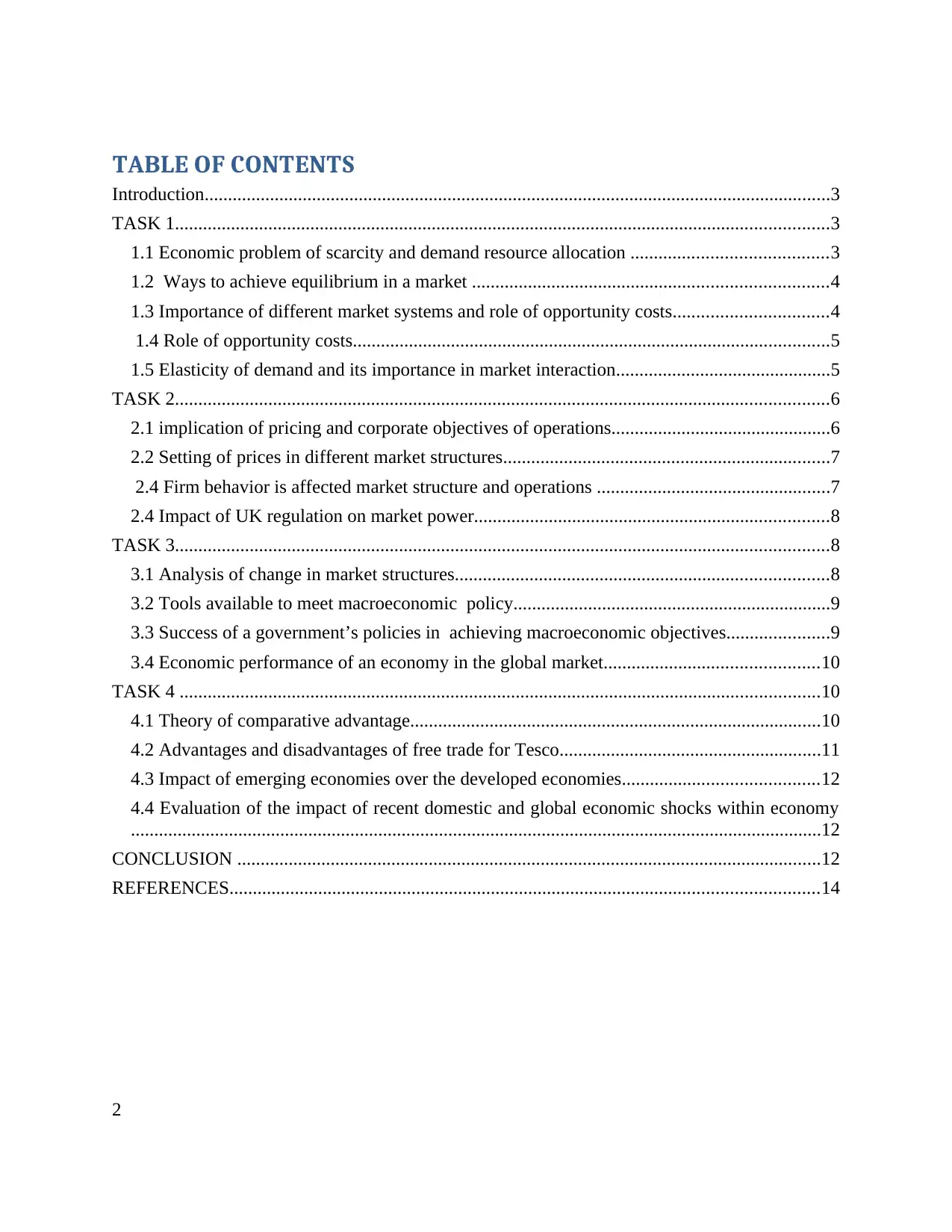
TABLE OF CONTENTS
Introduction......................................................................................................................................3
TASK 1............................................................................................................................................3
1.1 Economic problem of scarcity and demand resource allocation ..........................................3
1.2 Ways to achieve equilibrium in a market ............................................................................4
1.3 Importance of different market systems and role of opportunity costs.................................4
1.4 Role of opportunity costs......................................................................................................5
1.5 Elasticity of demand and its importance in market interaction..............................................5
TASK 2............................................................................................................................................6
2.1 implication of pricing and corporate objectives of operations...............................................6
2.2 Setting of prices in different market structures......................................................................7
2.4 Firm behavior is affected market structure and operations ..................................................7
2.4 Impact of UK regulation on market power............................................................................8
TASK 3............................................................................................................................................8
3.1 Analysis of change in market structures................................................................................8
3.2 Tools available to meet macroeconomic policy....................................................................9
3.3 Success of a government’s policies in achieving macroeconomic objectives......................9
3.4 Economic performance of an economy in the global market..............................................10
TASK 4 .........................................................................................................................................10
4.1 Theory of comparative advantage........................................................................................10
4.2 Advantages and disadvantages of free trade for Tesco........................................................11
4.3 Impact of emerging economies over the developed economies..........................................12
4.4 Evaluation of the impact of recent domestic and global economic shocks within economy
....................................................................................................................................................12
CONCLUSION .............................................................................................................................12
REFERENCES..............................................................................................................................14
2
Introduction......................................................................................................................................3
TASK 1............................................................................................................................................3
1.1 Economic problem of scarcity and demand resource allocation ..........................................3
1.2 Ways to achieve equilibrium in a market ............................................................................4
1.3 Importance of different market systems and role of opportunity costs.................................4
1.4 Role of opportunity costs......................................................................................................5
1.5 Elasticity of demand and its importance in market interaction..............................................5
TASK 2............................................................................................................................................6
2.1 implication of pricing and corporate objectives of operations...............................................6
2.2 Setting of prices in different market structures......................................................................7
2.4 Firm behavior is affected market structure and operations ..................................................7
2.4 Impact of UK regulation on market power............................................................................8
TASK 3............................................................................................................................................8
3.1 Analysis of change in market structures................................................................................8
3.2 Tools available to meet macroeconomic policy....................................................................9
3.3 Success of a government’s policies in achieving macroeconomic objectives......................9
3.4 Economic performance of an economy in the global market..............................................10
TASK 4 .........................................................................................................................................10
4.1 Theory of comparative advantage........................................................................................10
4.2 Advantages and disadvantages of free trade for Tesco........................................................11
4.3 Impact of emerging economies over the developed economies..........................................12
4.4 Evaluation of the impact of recent domestic and global economic shocks within economy
....................................................................................................................................................12
CONCLUSION .............................................................................................................................12
REFERENCES..............................................................................................................................14
2
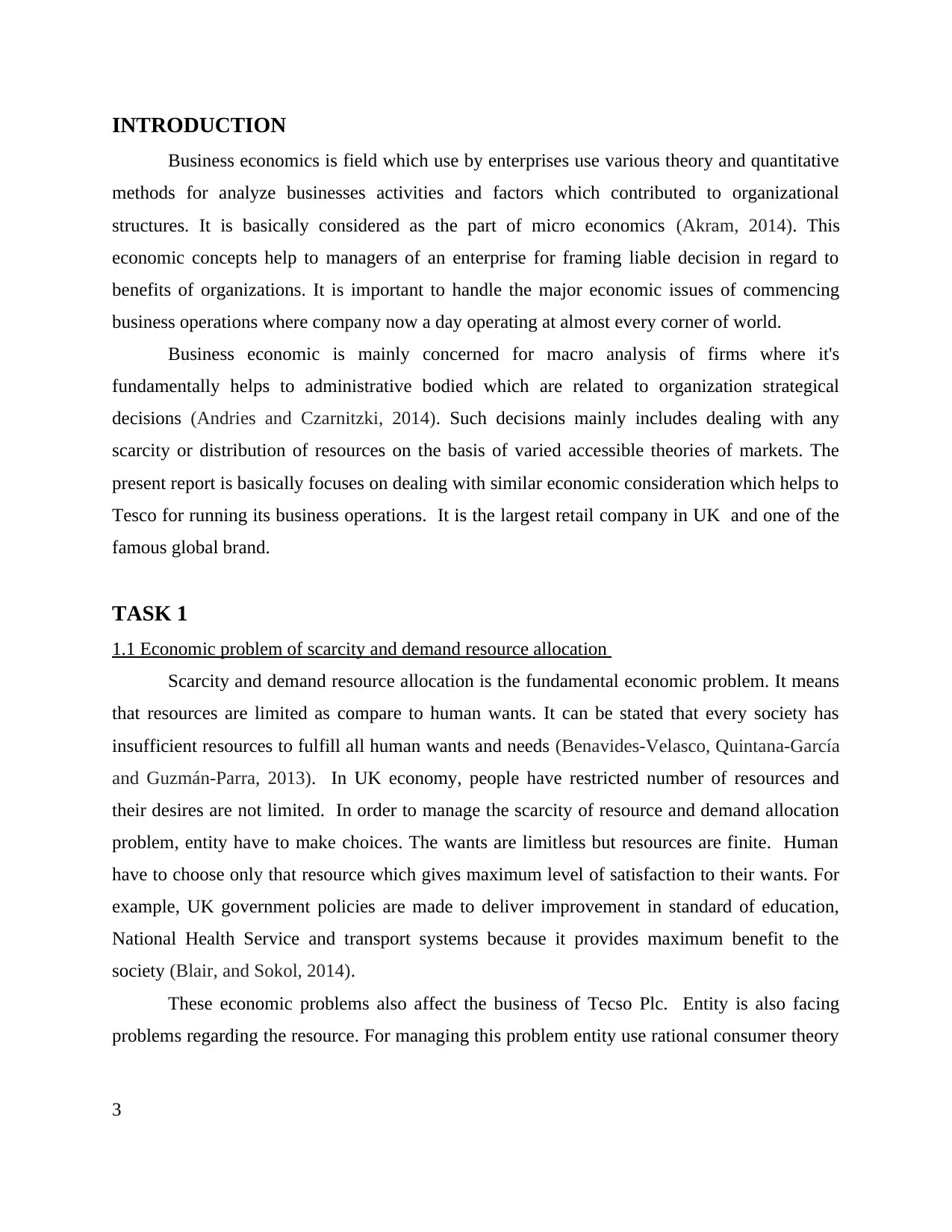
INTRODUCTION
Business economics is field which use by enterprises use various theory and quantitative
methods for analyze businesses activities and factors which contributed to organizational
structures. It is basically considered as the part of micro economics (Akram, 2014). This
economic concepts help to managers of an enterprise for framing liable decision in regard to
benefits of organizations. It is important to handle the major economic issues of commencing
business operations where company now a day operating at almost every corner of world.
Business economic is mainly concerned for macro analysis of firms where it's
fundamentally helps to administrative bodied which are related to organization strategical
decisions (Andries and Czarnitzki, 2014). Such decisions mainly includes dealing with any
scarcity or distribution of resources on the basis of varied accessible theories of markets. The
present report is basically focuses on dealing with similar economic consideration which helps to
Tesco for running its business operations. It is the largest retail company in UK and one of the
famous global brand.
TASK 1
1.1 Economic problem of scarcity and demand resource allocation
Scarcity and demand resource allocation is the fundamental economic problem. It means
that resources are limited as compare to human wants. It can be stated that every society has
insufficient resources to fulfill all human wants and needs (Benavides-Velasco, Quintana-García
and Guzmán-Parra, 2013). In UK economy, people have restricted number of resources and
their desires are not limited. In order to manage the scarcity of resource and demand allocation
problem, entity have to make choices. The wants are limitless but resources are finite. Human
have to choose only that resource which gives maximum level of satisfaction to their wants. For
example, UK government policies are made to deliver improvement in standard of education,
National Health Service and transport systems because it provides maximum benefit to the
society (Blair, and Sokol, 2014).
These economic problems also affect the business of Tecso Plc. Entity is also facing
problems regarding the resource. For managing this problem entity use rational consumer theory
3
Business economics is field which use by enterprises use various theory and quantitative
methods for analyze businesses activities and factors which contributed to organizational
structures. It is basically considered as the part of micro economics (Akram, 2014). This
economic concepts help to managers of an enterprise for framing liable decision in regard to
benefits of organizations. It is important to handle the major economic issues of commencing
business operations where company now a day operating at almost every corner of world.
Business economic is mainly concerned for macro analysis of firms where it's
fundamentally helps to administrative bodied which are related to organization strategical
decisions (Andries and Czarnitzki, 2014). Such decisions mainly includes dealing with any
scarcity or distribution of resources on the basis of varied accessible theories of markets. The
present report is basically focuses on dealing with similar economic consideration which helps to
Tesco for running its business operations. It is the largest retail company in UK and one of the
famous global brand.
TASK 1
1.1 Economic problem of scarcity and demand resource allocation
Scarcity and demand resource allocation is the fundamental economic problem. It means
that resources are limited as compare to human wants. It can be stated that every society has
insufficient resources to fulfill all human wants and needs (Benavides-Velasco, Quintana-García
and Guzmán-Parra, 2013). In UK economy, people have restricted number of resources and
their desires are not limited. In order to manage the scarcity of resource and demand allocation
problem, entity have to make choices. The wants are limitless but resources are finite. Human
have to choose only that resource which gives maximum level of satisfaction to their wants. For
example, UK government policies are made to deliver improvement in standard of education,
National Health Service and transport systems because it provides maximum benefit to the
society (Blair, and Sokol, 2014).
These economic problems also affect the business of Tecso Plc. Entity is also facing
problems regarding the resource. For managing this problem entity use rational consumer theory
3
⊘ This is a preview!⊘
Do you want full access?
Subscribe today to unlock all pages.

Trusted by 1+ million students worldwide
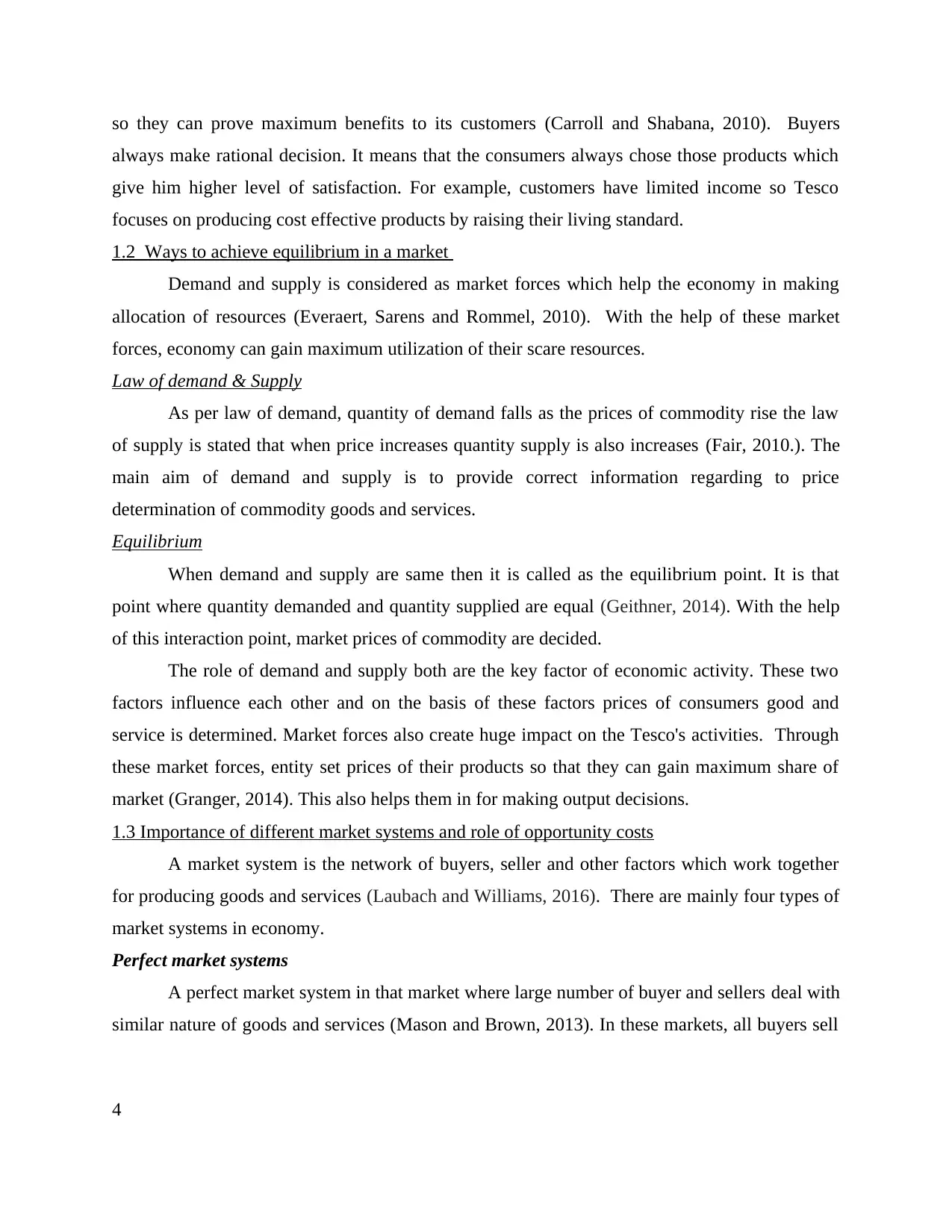
so they can prove maximum benefits to its customers (Carroll and Shabana, 2010). Buyers
always make rational decision. It means that the consumers always chose those products which
give him higher level of satisfaction. For example, customers have limited income so Tesco
focuses on producing cost effective products by raising their living standard.
1.2 Ways to achieve equilibrium in a market
Demand and supply is considered as market forces which help the economy in making
allocation of resources (Everaert, Sarens and Rommel, 2010). With the help of these market
forces, economy can gain maximum utilization of their scare resources.
Law of demand & Supply
As per law of demand, quantity of demand falls as the prices of commodity rise the law
of supply is stated that when price increases quantity supply is also increases (Fair, 2010.). The
main aim of demand and supply is to provide correct information regarding to price
determination of commodity goods and services.
Equilibrium
When demand and supply are same then it is called as the equilibrium point. It is that
point where quantity demanded and quantity supplied are equal (Geithner, 2014). With the help
of this interaction point, market prices of commodity are decided.
The role of demand and supply both are the key factor of economic activity. These two
factors influence each other and on the basis of these factors prices of consumers good and
service is determined. Market forces also create huge impact on the Tesco's activities. Through
these market forces, entity set prices of their products so that they can gain maximum share of
market (Granger, 2014). This also helps them in for making output decisions.
1.3 Importance of different market systems and role of opportunity costs
A market system is the network of buyers, seller and other factors which work together
for producing goods and services (Laubach and Williams, 2016). There are mainly four types of
market systems in economy.
Perfect market systems
A perfect market system in that market where large number of buyer and sellers deal with
similar nature of goods and services (Mason and Brown, 2013). In these markets, all buyers sell
4
always make rational decision. It means that the consumers always chose those products which
give him higher level of satisfaction. For example, customers have limited income so Tesco
focuses on producing cost effective products by raising their living standard.
1.2 Ways to achieve equilibrium in a market
Demand and supply is considered as market forces which help the economy in making
allocation of resources (Everaert, Sarens and Rommel, 2010). With the help of these market
forces, economy can gain maximum utilization of their scare resources.
Law of demand & Supply
As per law of demand, quantity of demand falls as the prices of commodity rise the law
of supply is stated that when price increases quantity supply is also increases (Fair, 2010.). The
main aim of demand and supply is to provide correct information regarding to price
determination of commodity goods and services.
Equilibrium
When demand and supply are same then it is called as the equilibrium point. It is that
point where quantity demanded and quantity supplied are equal (Geithner, 2014). With the help
of this interaction point, market prices of commodity are decided.
The role of demand and supply both are the key factor of economic activity. These two
factors influence each other and on the basis of these factors prices of consumers good and
service is determined. Market forces also create huge impact on the Tesco's activities. Through
these market forces, entity set prices of their products so that they can gain maximum share of
market (Granger, 2014). This also helps them in for making output decisions.
1.3 Importance of different market systems and role of opportunity costs
A market system is the network of buyers, seller and other factors which work together
for producing goods and services (Laubach and Williams, 2016). There are mainly four types of
market systems in economy.
Perfect market systems
A perfect market system in that market where large number of buyer and sellers deal with
similar nature of goods and services (Mason and Brown, 2013). In these markets, all buyers sell
4
Paraphrase This Document
Need a fresh take? Get an instant paraphrase of this document with our AI Paraphraser
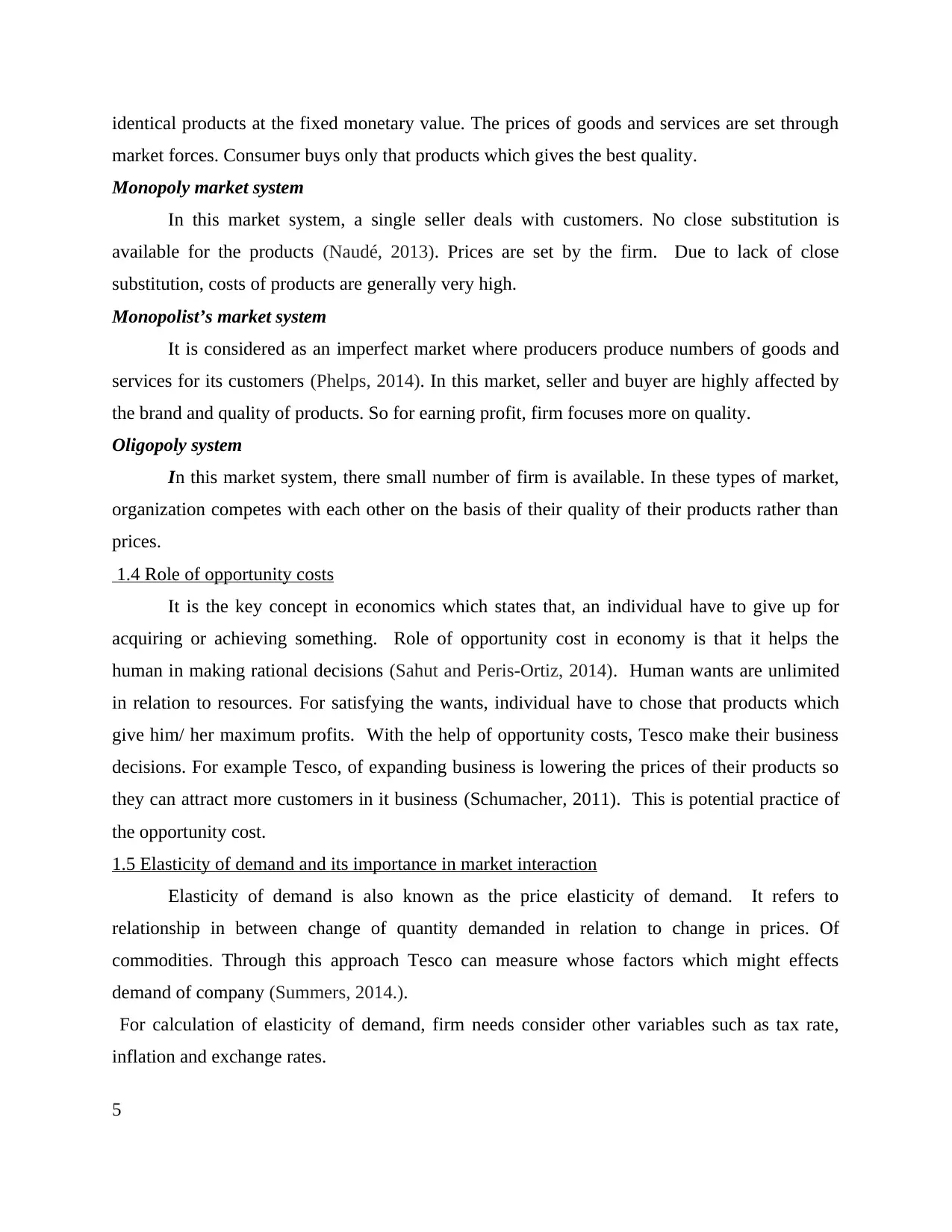
identical products at the fixed monetary value. The prices of goods and services are set through
market forces. Consumer buys only that products which gives the best quality.
Monopoly market system
In this market system, a single seller deals with customers. No close substitution is
available for the products (Naudé, 2013). Prices are set by the firm. Due to lack of close
substitution, costs of products are generally very high.
Monopolist’s market system
It is considered as an imperfect market where producers produce numbers of goods and
services for its customers (Phelps, 2014). In this market, seller and buyer are highly affected by
the brand and quality of products. So for earning profit, firm focuses more on quality.
Oligopoly system
In this market system, there small number of firm is available. In these types of market,
organization competes with each other on the basis of their quality of their products rather than
prices.
1.4 Role of opportunity costs
It is the key concept in economics which states that, an individual have to give up for
acquiring or achieving something. Role of opportunity cost in economy is that it helps the
human in making rational decisions (Sahut and Peris-Ortiz, 2014). Human wants are unlimited
in relation to resources. For satisfying the wants, individual have to chose that products which
give him/ her maximum profits. With the help of opportunity costs, Tesco make their business
decisions. For example Tesco, of expanding business is lowering the prices of their products so
they can attract more customers in it business (Schumacher, 2011). This is potential practice of
the opportunity cost.
1.5 Elasticity of demand and its importance in market interaction
Elasticity of demand is also known as the price elasticity of demand. It refers to
relationship in between change of quantity demanded in relation to change in prices. Of
commodities. Through this approach Tesco can measure whose factors which might effects
demand of company (Summers, 2014.).
For calculation of elasticity of demand, firm needs consider other variables such as tax rate,
inflation and exchange rates.
5
market forces. Consumer buys only that products which gives the best quality.
Monopoly market system
In this market system, a single seller deals with customers. No close substitution is
available for the products (Naudé, 2013). Prices are set by the firm. Due to lack of close
substitution, costs of products are generally very high.
Monopolist’s market system
It is considered as an imperfect market where producers produce numbers of goods and
services for its customers (Phelps, 2014). In this market, seller and buyer are highly affected by
the brand and quality of products. So for earning profit, firm focuses more on quality.
Oligopoly system
In this market system, there small number of firm is available. In these types of market,
organization competes with each other on the basis of their quality of their products rather than
prices.
1.4 Role of opportunity costs
It is the key concept in economics which states that, an individual have to give up for
acquiring or achieving something. Role of opportunity cost in economy is that it helps the
human in making rational decisions (Sahut and Peris-Ortiz, 2014). Human wants are unlimited
in relation to resources. For satisfying the wants, individual have to chose that products which
give him/ her maximum profits. With the help of opportunity costs, Tesco make their business
decisions. For example Tesco, of expanding business is lowering the prices of their products so
they can attract more customers in it business (Schumacher, 2011). This is potential practice of
the opportunity cost.
1.5 Elasticity of demand and its importance in market interaction
Elasticity of demand is also known as the price elasticity of demand. It refers to
relationship in between change of quantity demanded in relation to change in prices. Of
commodities. Through this approach Tesco can measure whose factors which might effects
demand of company (Summers, 2014.).
For calculation of elasticity of demand, firm needs consider other variables such as tax rate,
inflation and exchange rates.
5
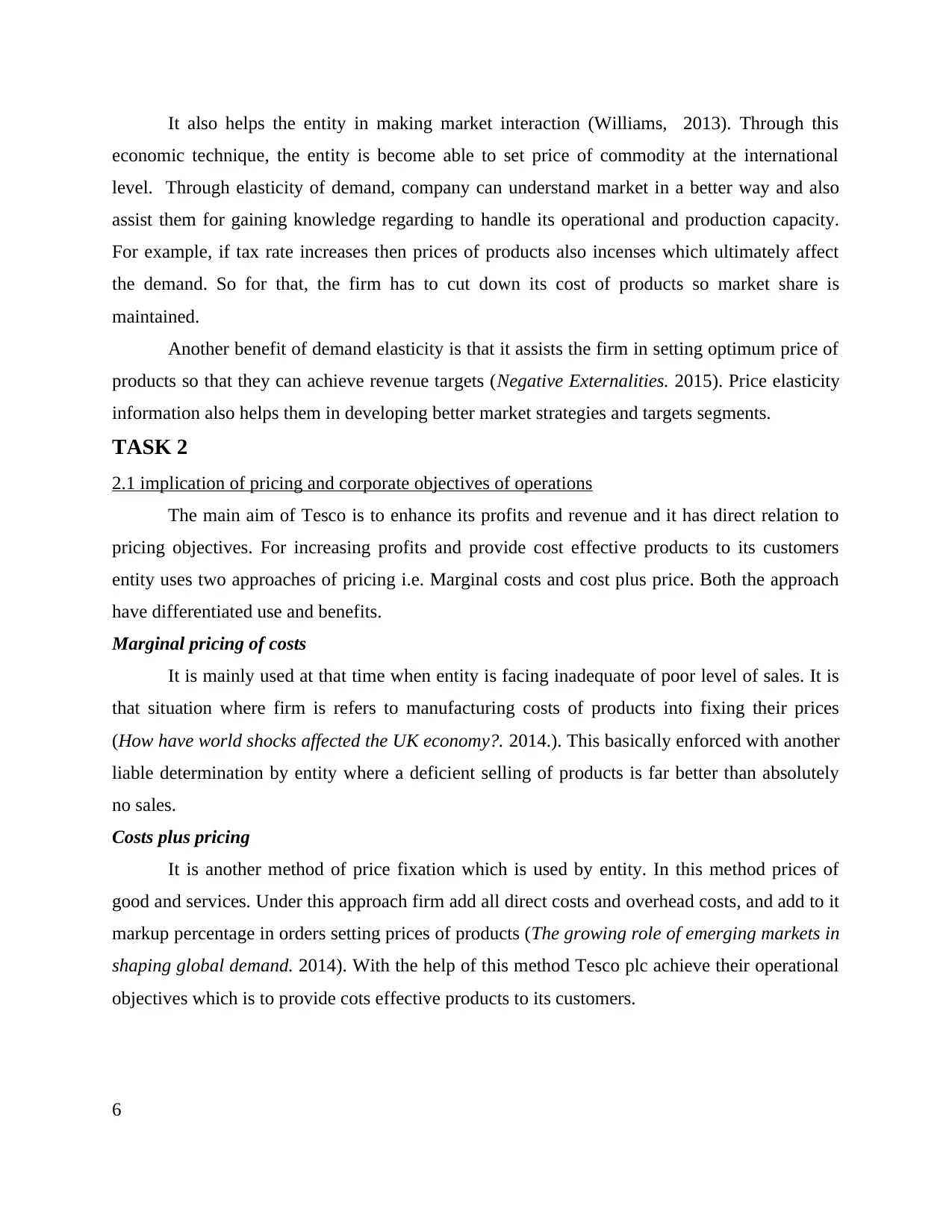
It also helps the entity in making market interaction (Williams, 2013). Through this
economic technique, the entity is become able to set price of commodity at the international
level. Through elasticity of demand, company can understand market in a better way and also
assist them for gaining knowledge regarding to handle its operational and production capacity.
For example, if tax rate increases then prices of products also incenses which ultimately affect
the demand. So for that, the firm has to cut down its cost of products so market share is
maintained.
Another benefit of demand elasticity is that it assists the firm in setting optimum price of
products so that they can achieve revenue targets (Negative Externalities. 2015). Price elasticity
information also helps them in developing better market strategies and targets segments.
TASK 2
2.1 implication of pricing and corporate objectives of operations
The main aim of Tesco is to enhance its profits and revenue and it has direct relation to
pricing objectives. For increasing profits and provide cost effective products to its customers
entity uses two approaches of pricing i.e. Marginal costs and cost plus price. Both the approach
have differentiated use and benefits.
Marginal pricing of costs
It is mainly used at that time when entity is facing inadequate of poor level of sales. It is
that situation where firm is refers to manufacturing costs of products into fixing their prices
(How have world shocks affected the UK economy?. 2014.). This basically enforced with another
liable determination by entity where a deficient selling of products is far better than absolutely
no sales.
Costs plus pricing
It is another method of price fixation which is used by entity. In this method prices of
good and services. Under this approach firm add all direct costs and overhead costs, and add to it
markup percentage in orders setting prices of products (The growing role of emerging markets in
shaping global demand. 2014). With the help of this method Tesco plc achieve their operational
objectives which is to provide cots effective products to its customers.
6
economic technique, the entity is become able to set price of commodity at the international
level. Through elasticity of demand, company can understand market in a better way and also
assist them for gaining knowledge regarding to handle its operational and production capacity.
For example, if tax rate increases then prices of products also incenses which ultimately affect
the demand. So for that, the firm has to cut down its cost of products so market share is
maintained.
Another benefit of demand elasticity is that it assists the firm in setting optimum price of
products so that they can achieve revenue targets (Negative Externalities. 2015). Price elasticity
information also helps them in developing better market strategies and targets segments.
TASK 2
2.1 implication of pricing and corporate objectives of operations
The main aim of Tesco is to enhance its profits and revenue and it has direct relation to
pricing objectives. For increasing profits and provide cost effective products to its customers
entity uses two approaches of pricing i.e. Marginal costs and cost plus price. Both the approach
have differentiated use and benefits.
Marginal pricing of costs
It is mainly used at that time when entity is facing inadequate of poor level of sales. It is
that situation where firm is refers to manufacturing costs of products into fixing their prices
(How have world shocks affected the UK economy?. 2014.). This basically enforced with another
liable determination by entity where a deficient selling of products is far better than absolutely
no sales.
Costs plus pricing
It is another method of price fixation which is used by entity. In this method prices of
good and services. Under this approach firm add all direct costs and overhead costs, and add to it
markup percentage in orders setting prices of products (The growing role of emerging markets in
shaping global demand. 2014). With the help of this method Tesco plc achieve their operational
objectives which is to provide cots effective products to its customers.
6
⊘ This is a preview!⊘
Do you want full access?
Subscribe today to unlock all pages.

Trusted by 1+ million students worldwide
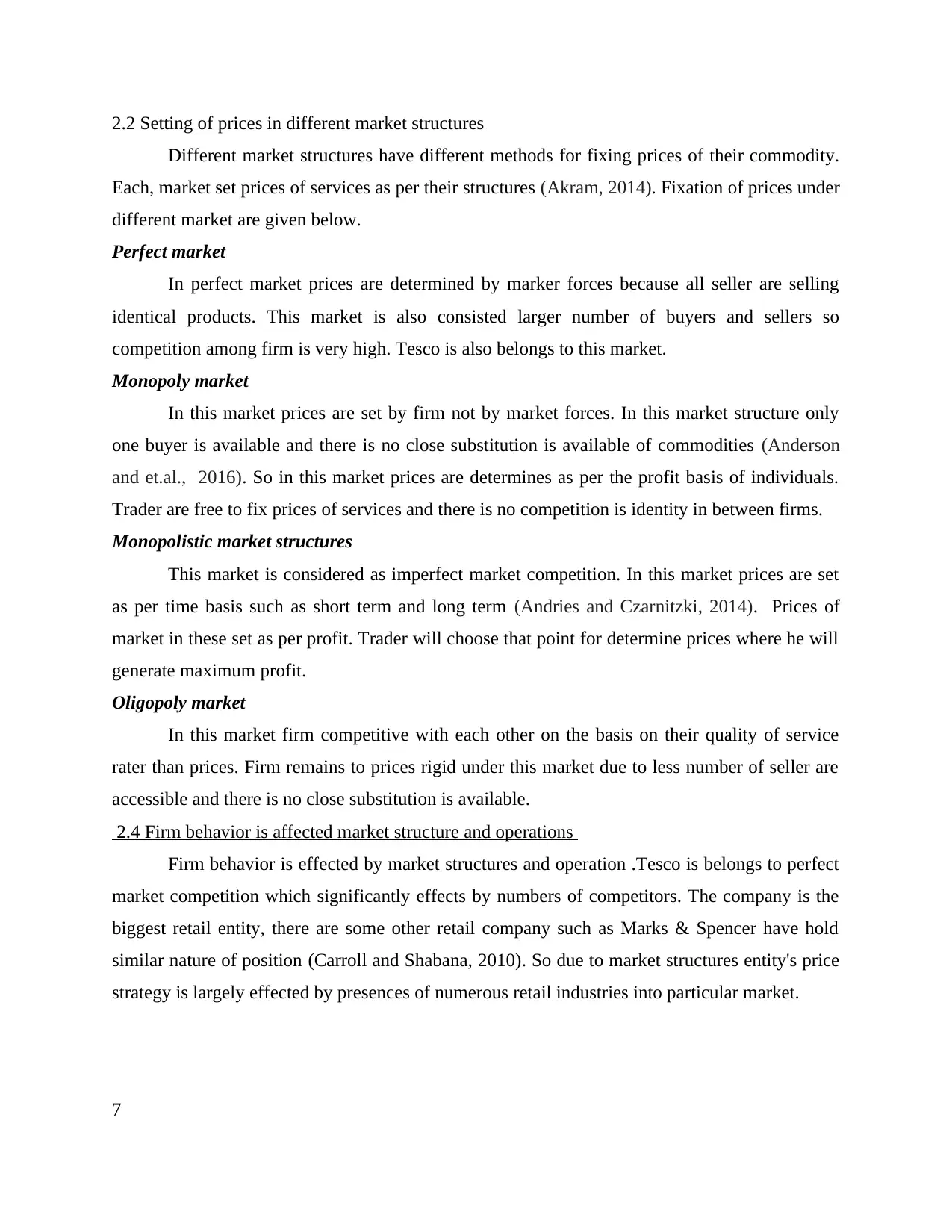
2.2 Setting of prices in different market structures
Different market structures have different methods for fixing prices of their commodity.
Each, market set prices of services as per their structures (Akram, 2014). Fixation of prices under
different market are given below.
Perfect market
In perfect market prices are determined by marker forces because all seller are selling
identical products. This market is also consisted larger number of buyers and sellers so
competition among firm is very high. Tesco is also belongs to this market.
Monopoly market
In this market prices are set by firm not by market forces. In this market structure only
one buyer is available and there is no close substitution is available of commodities (Anderson
and et.al., 2016). So in this market prices are determines as per the profit basis of individuals.
Trader are free to fix prices of services and there is no competition is identity in between firms.
Monopolistic market structures
This market is considered as imperfect market competition. In this market prices are set
as per time basis such as short term and long term (Andries and Czarnitzki, 2014). Prices of
market in these set as per profit. Trader will choose that point for determine prices where he will
generate maximum profit.
Oligopoly market
In this market firm competitive with each other on the basis on their quality of service
rater than prices. Firm remains to prices rigid under this market due to less number of seller are
accessible and there is no close substitution is available.
2.4 Firm behavior is affected market structure and operations
Firm behavior is effected by market structures and operation .Tesco is belongs to perfect
market competition which significantly effects by numbers of competitors. The company is the
biggest retail entity, there are some other retail company such as Marks & Spencer have hold
similar nature of position (Carroll and Shabana, 2010). So due to market structures entity's price
strategy is largely effected by presences of numerous retail industries into particular market.
7
Different market structures have different methods for fixing prices of their commodity.
Each, market set prices of services as per their structures (Akram, 2014). Fixation of prices under
different market are given below.
Perfect market
In perfect market prices are determined by marker forces because all seller are selling
identical products. This market is also consisted larger number of buyers and sellers so
competition among firm is very high. Tesco is also belongs to this market.
Monopoly market
In this market prices are set by firm not by market forces. In this market structure only
one buyer is available and there is no close substitution is available of commodities (Anderson
and et.al., 2016). So in this market prices are determines as per the profit basis of individuals.
Trader are free to fix prices of services and there is no competition is identity in between firms.
Monopolistic market structures
This market is considered as imperfect market competition. In this market prices are set
as per time basis such as short term and long term (Andries and Czarnitzki, 2014). Prices of
market in these set as per profit. Trader will choose that point for determine prices where he will
generate maximum profit.
Oligopoly market
In this market firm competitive with each other on the basis on their quality of service
rater than prices. Firm remains to prices rigid under this market due to less number of seller are
accessible and there is no close substitution is available.
2.4 Firm behavior is affected market structure and operations
Firm behavior is effected by market structures and operation .Tesco is belongs to perfect
market competition which significantly effects by numbers of competitors. The company is the
biggest retail entity, there are some other retail company such as Marks & Spencer have hold
similar nature of position (Carroll and Shabana, 2010). So due to market structures entity's price
strategy is largely effected by presences of numerous retail industries into particular market.
7
Paraphrase This Document
Need a fresh take? Get an instant paraphrase of this document with our AI Paraphraser

Another impact of marker structure is that Tesco is in perfect market competition and all
firm are selling identical products to everyone. So for surviving in the market it is necessary for
them to maintain quality in its commodity along with low cost.
2.4 Impact of UK regulation on market power
There are several types of regulation which implies on entity. These regulation create
huge impact on firm and its market structures. It is mandatory to follows such rules and
regulation for Tesco for running its business operation smoothly (Benavides-Velasco, Quintana-
García and Guzmán-Parra, 2013). Following are impacts regulation which imposed on UK
organizations.
Minimum wage Act, 1998
As per this Act, Tesco have to pay minimum wages to its workers. This regulation is
enforced to every firm. As according to this law, entity have to pay £7.20 per hour for each
worker. Impact of this law is that entity have to pay minimum wages to their workers (Fair,
2010). If organization fails, to follow this law then workers can claim judicially charge on firm.
Working Time Directive Act, 1998
This act focuses on that on providing minimum rest breaks, daily rest and
maximum working hours for its workers. As according to this each and every employees may not
work more than 48 hours per weak. Impact of this regulation is that entity have to set fix
schedule for individuals who arr working as full -time or part -time in firm. It is statutory laws so
Tesco have to follow this law.
TASK 3
3.1 Analysis of change in market structures
In 21 century came up with many significantly changes. There are numbers of
modification are appeared in social, cultural, economical, legal and political aspect which
encourage to nation's economy and industry's growth (Laubach and Williams, 2016). 21st century
brings many more changes in all human life such as increases in living standard of people and
income distribution among people. Use of advance technology ha also created huge impact on
market structures.
8
firm are selling identical products to everyone. So for surviving in the market it is necessary for
them to maintain quality in its commodity along with low cost.
2.4 Impact of UK regulation on market power
There are several types of regulation which implies on entity. These regulation create
huge impact on firm and its market structures. It is mandatory to follows such rules and
regulation for Tesco for running its business operation smoothly (Benavides-Velasco, Quintana-
García and Guzmán-Parra, 2013). Following are impacts regulation which imposed on UK
organizations.
Minimum wage Act, 1998
As per this Act, Tesco have to pay minimum wages to its workers. This regulation is
enforced to every firm. As according to this law, entity have to pay £7.20 per hour for each
worker. Impact of this law is that entity have to pay minimum wages to their workers (Fair,
2010). If organization fails, to follow this law then workers can claim judicially charge on firm.
Working Time Directive Act, 1998
This act focuses on that on providing minimum rest breaks, daily rest and
maximum working hours for its workers. As according to this each and every employees may not
work more than 48 hours per weak. Impact of this regulation is that entity have to set fix
schedule for individuals who arr working as full -time or part -time in firm. It is statutory laws so
Tesco have to follow this law.
TASK 3
3.1 Analysis of change in market structures
In 21 century came up with many significantly changes. There are numbers of
modification are appeared in social, cultural, economical, legal and political aspect which
encourage to nation's economy and industry's growth (Laubach and Williams, 2016). 21st century
brings many more changes in all human life such as increases in living standard of people and
income distribution among people. Use of advance technology ha also created huge impact on
market structures.
8
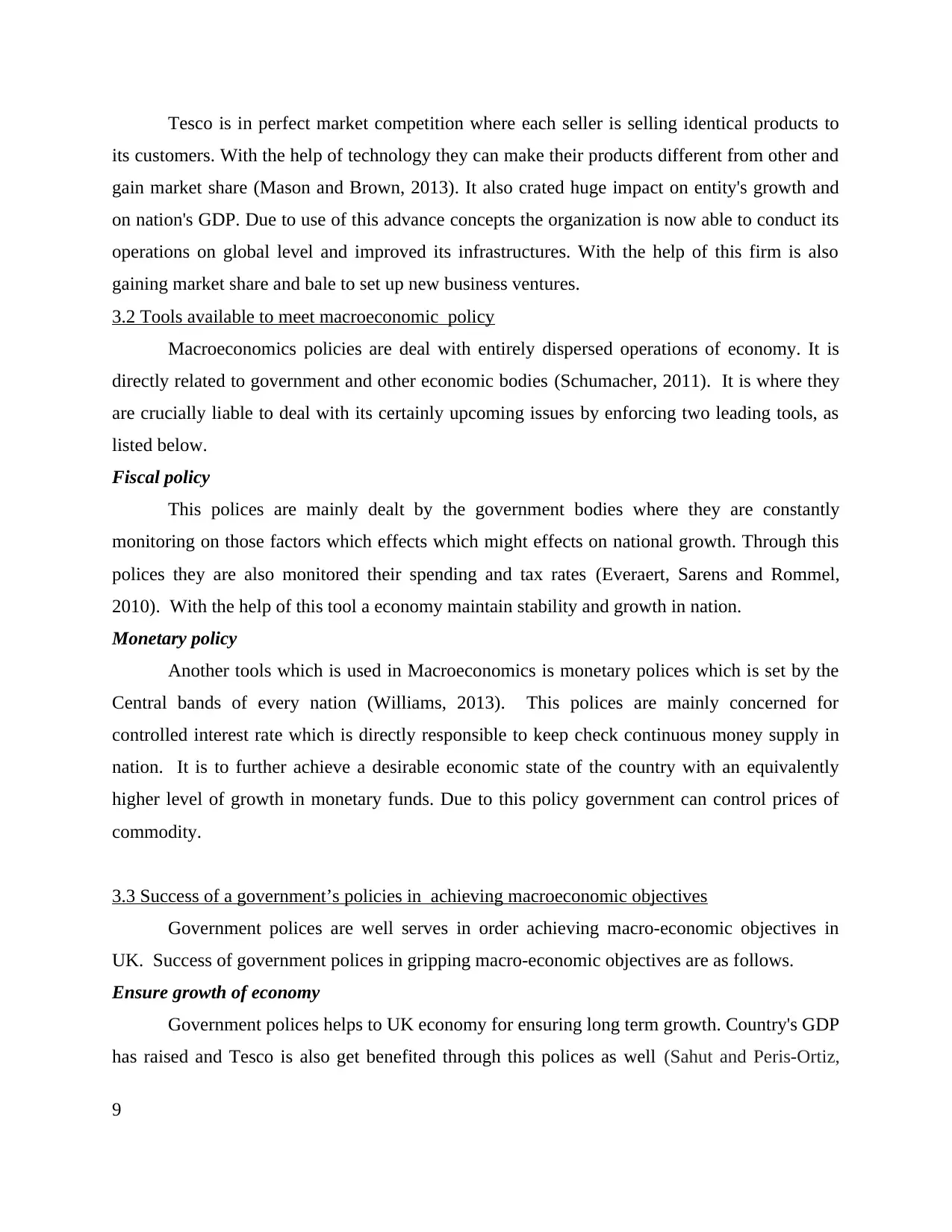
Tesco is in perfect market competition where each seller is selling identical products to
its customers. With the help of technology they can make their products different from other and
gain market share (Mason and Brown, 2013). It also crated huge impact on entity's growth and
on nation's GDP. Due to use of this advance concepts the organization is now able to conduct its
operations on global level and improved its infrastructures. With the help of this firm is also
gaining market share and bale to set up new business ventures.
3.2 Tools available to meet macroeconomic policy
Macroeconomics policies are deal with entirely dispersed operations of economy. It is
directly related to government and other economic bodies (Schumacher, 2011). It is where they
are crucially liable to deal with its certainly upcoming issues by enforcing two leading tools, as
listed below.
Fiscal policy
This polices are mainly dealt by the government bodies where they are constantly
monitoring on those factors which effects which might effects on national growth. Through this
polices they are also monitored their spending and tax rates (Everaert, Sarens and Rommel,
2010). With the help of this tool a economy maintain stability and growth in nation.
Monetary policy
Another tools which is used in Macroeconomics is monetary polices which is set by the
Central bands of every nation (Williams, 2013). This polices are mainly concerned for
controlled interest rate which is directly responsible to keep check continuous money supply in
nation. It is to further achieve a desirable economic state of the country with an equivalently
higher level of growth in monetary funds. Due to this policy government can control prices of
commodity.
3.3 Success of a government’s policies in achieving macroeconomic objectives
Government polices are well serves in order achieving macro-economic objectives in
UK. Success of government polices in gripping macro-economic objectives are as follows.
Ensure growth of economy
Government polices helps to UK economy for ensuring long term growth. Country's GDP
has raised and Tesco is also get benefited through this polices as well (Sahut and Peris-Ortiz,
9
its customers. With the help of technology they can make their products different from other and
gain market share (Mason and Brown, 2013). It also crated huge impact on entity's growth and
on nation's GDP. Due to use of this advance concepts the organization is now able to conduct its
operations on global level and improved its infrastructures. With the help of this firm is also
gaining market share and bale to set up new business ventures.
3.2 Tools available to meet macroeconomic policy
Macroeconomics policies are deal with entirely dispersed operations of economy. It is
directly related to government and other economic bodies (Schumacher, 2011). It is where they
are crucially liable to deal with its certainly upcoming issues by enforcing two leading tools, as
listed below.
Fiscal policy
This polices are mainly dealt by the government bodies where they are constantly
monitoring on those factors which effects which might effects on national growth. Through this
polices they are also monitored their spending and tax rates (Everaert, Sarens and Rommel,
2010). With the help of this tool a economy maintain stability and growth in nation.
Monetary policy
Another tools which is used in Macroeconomics is monetary polices which is set by the
Central bands of every nation (Williams, 2013). This polices are mainly concerned for
controlled interest rate which is directly responsible to keep check continuous money supply in
nation. It is to further achieve a desirable economic state of the country with an equivalently
higher level of growth in monetary funds. Due to this policy government can control prices of
commodity.
3.3 Success of a government’s policies in achieving macroeconomic objectives
Government polices are well serves in order achieving macro-economic objectives in
UK. Success of government polices in gripping macro-economic objectives are as follows.
Ensure growth of economy
Government polices helps to UK economy for ensuring long term growth. Country's GDP
has raised and Tesco is also get benefited through this polices as well (Sahut and Peris-Ortiz,
9
⊘ This is a preview!⊘
Do you want full access?
Subscribe today to unlock all pages.

Trusted by 1+ million students worldwide
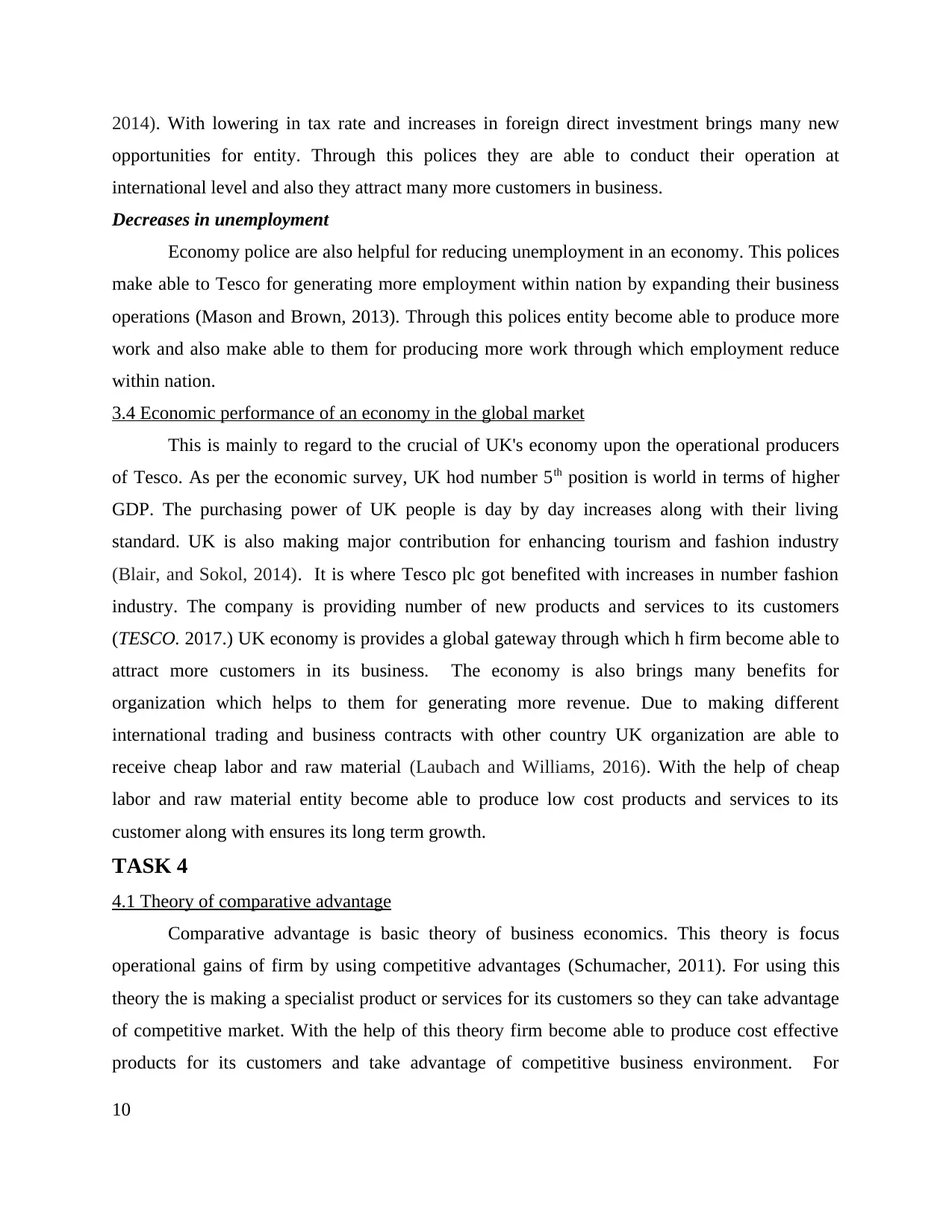
2014). With lowering in tax rate and increases in foreign direct investment brings many new
opportunities for entity. Through this polices they are able to conduct their operation at
international level and also they attract many more customers in business.
Decreases in unemployment
Economy police are also helpful for reducing unemployment in an economy. This polices
make able to Tesco for generating more employment within nation by expanding their business
operations (Mason and Brown, 2013). Through this polices entity become able to produce more
work and also make able to them for producing more work through which employment reduce
within nation.
3.4 Economic performance of an economy in the global market
This is mainly to regard to the crucial of UK's economy upon the operational producers
of Tesco. As per the economic survey, UK hod number 5th position is world in terms of higher
GDP. The purchasing power of UK people is day by day increases along with their living
standard. UK is also making major contribution for enhancing tourism and fashion industry
(Blair, and Sokol, 2014). It is where Tesco plc got benefited with increases in number fashion
industry. The company is providing number of new products and services to its customers
(TESCO. 2017.) UK economy is provides a global gateway through which h firm become able to
attract more customers in its business. The economy is also brings many benefits for
organization which helps to them for generating more revenue. Due to making different
international trading and business contracts with other country UK organization are able to
receive cheap labor and raw material (Laubach and Williams, 2016). With the help of cheap
labor and raw material entity become able to produce low cost products and services to its
customer along with ensures its long term growth.
TASK 4
4.1 Theory of comparative advantage
Comparative advantage is basic theory of business economics. This theory is focus
operational gains of firm by using competitive advantages (Schumacher, 2011). For using this
theory the is making a specialist product or services for its customers so they can take advantage
of competitive market. With the help of this theory firm become able to produce cost effective
products for its customers and take advantage of competitive business environment. For
10
opportunities for entity. Through this polices they are able to conduct their operation at
international level and also they attract many more customers in business.
Decreases in unemployment
Economy police are also helpful for reducing unemployment in an economy. This polices
make able to Tesco for generating more employment within nation by expanding their business
operations (Mason and Brown, 2013). Through this polices entity become able to produce more
work and also make able to them for producing more work through which employment reduce
within nation.
3.4 Economic performance of an economy in the global market
This is mainly to regard to the crucial of UK's economy upon the operational producers
of Tesco. As per the economic survey, UK hod number 5th position is world in terms of higher
GDP. The purchasing power of UK people is day by day increases along with their living
standard. UK is also making major contribution for enhancing tourism and fashion industry
(Blair, and Sokol, 2014). It is where Tesco plc got benefited with increases in number fashion
industry. The company is providing number of new products and services to its customers
(TESCO. 2017.) UK economy is provides a global gateway through which h firm become able to
attract more customers in its business. The economy is also brings many benefits for
organization which helps to them for generating more revenue. Due to making different
international trading and business contracts with other country UK organization are able to
receive cheap labor and raw material (Laubach and Williams, 2016). With the help of cheap
labor and raw material entity become able to produce low cost products and services to its
customer along with ensures its long term growth.
TASK 4
4.1 Theory of comparative advantage
Comparative advantage is basic theory of business economics. This theory is focus
operational gains of firm by using competitive advantages (Schumacher, 2011). For using this
theory the is making a specialist product or services for its customers so they can take advantage
of competitive market. With the help of this theory firm become able to produce cost effective
products for its customers and take advantage of competitive business environment. For
10
Paraphrase This Document
Need a fresh take? Get an instant paraphrase of this document with our AI Paraphraser
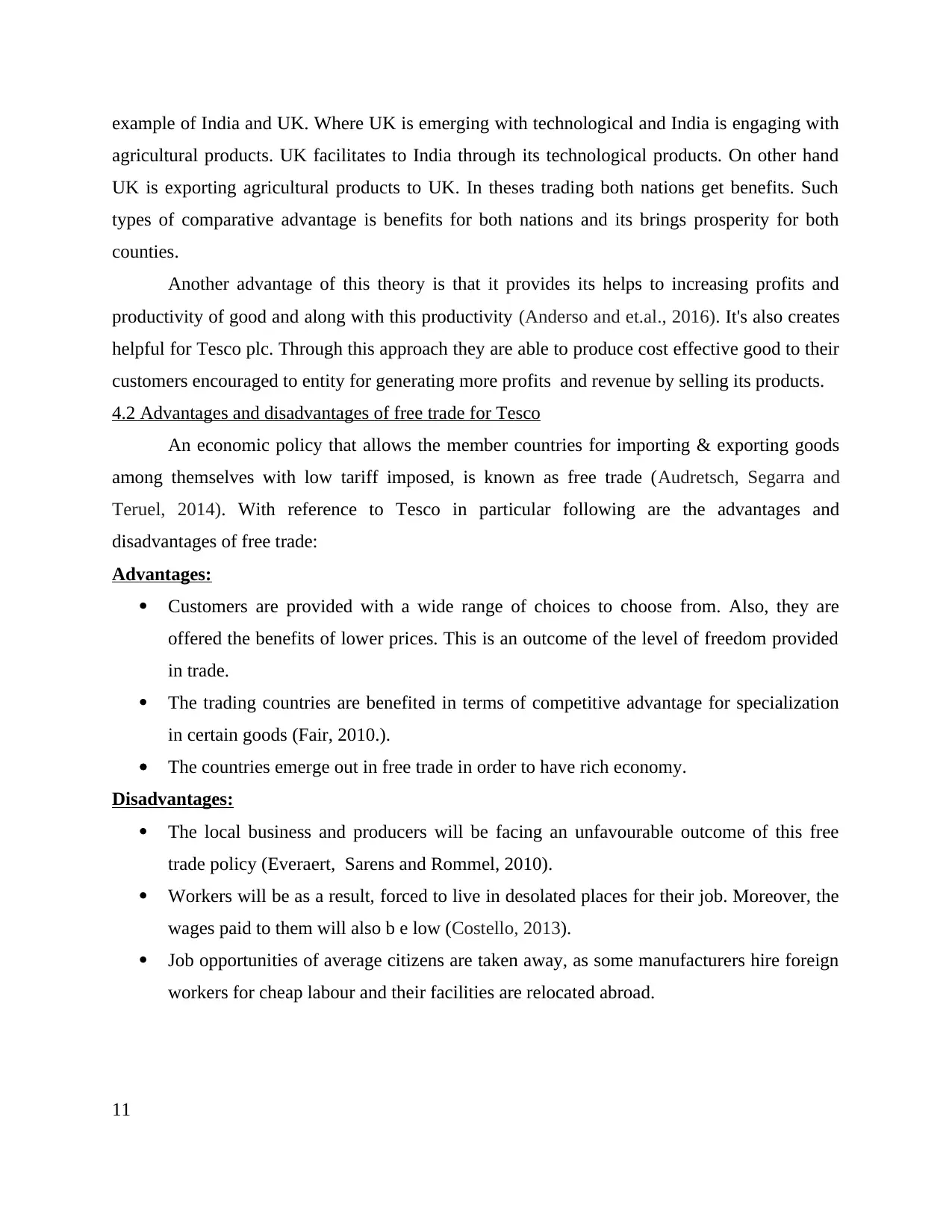
example of India and UK. Where UK is emerging with technological and India is engaging with
agricultural products. UK facilitates to India through its technological products. On other hand
UK is exporting agricultural products to UK. In theses trading both nations get benefits. Such
types of comparative advantage is benefits for both nations and its brings prosperity for both
counties.
Another advantage of this theory is that it provides its helps to increasing profits and
productivity of good and along with this productivity (Anderso and et.al., 2016). It's also creates
helpful for Tesco plc. Through this approach they are able to produce cost effective good to their
customers encouraged to entity for generating more profits and revenue by selling its products.
4.2 Advantages and disadvantages of free trade for Tesco
An economic policy that allows the member countries for importing & exporting goods
among themselves with low tariff imposed, is known as free trade (Audretsch, Segarra and
Teruel, 2014). With reference to Tesco in particular following are the advantages and
disadvantages of free trade:
Advantages:
Customers are provided with a wide range of choices to choose from. Also, they are
offered the benefits of lower prices. This is an outcome of the level of freedom provided
in trade.
The trading countries are benefited in terms of competitive advantage for specialization
in certain goods (Fair, 2010.).
The countries emerge out in free trade in order to have rich economy.
Disadvantages:
The local business and producers will be facing an unfavourable outcome of this free
trade policy (Everaert, Sarens and Rommel, 2010).
Workers will be as a result, forced to live in desolated places for their job. Moreover, the
wages paid to them will also b e low (Costello, 2013).
Job opportunities of average citizens are taken away, as some manufacturers hire foreign
workers for cheap labour and their facilities are relocated abroad.
11
agricultural products. UK facilitates to India through its technological products. On other hand
UK is exporting agricultural products to UK. In theses trading both nations get benefits. Such
types of comparative advantage is benefits for both nations and its brings prosperity for both
counties.
Another advantage of this theory is that it provides its helps to increasing profits and
productivity of good and along with this productivity (Anderso and et.al., 2016). It's also creates
helpful for Tesco plc. Through this approach they are able to produce cost effective good to their
customers encouraged to entity for generating more profits and revenue by selling its products.
4.2 Advantages and disadvantages of free trade for Tesco
An economic policy that allows the member countries for importing & exporting goods
among themselves with low tariff imposed, is known as free trade (Audretsch, Segarra and
Teruel, 2014). With reference to Tesco in particular following are the advantages and
disadvantages of free trade:
Advantages:
Customers are provided with a wide range of choices to choose from. Also, they are
offered the benefits of lower prices. This is an outcome of the level of freedom provided
in trade.
The trading countries are benefited in terms of competitive advantage for specialization
in certain goods (Fair, 2010.).
The countries emerge out in free trade in order to have rich economy.
Disadvantages:
The local business and producers will be facing an unfavourable outcome of this free
trade policy (Everaert, Sarens and Rommel, 2010).
Workers will be as a result, forced to live in desolated places for their job. Moreover, the
wages paid to them will also b e low (Costello, 2013).
Job opportunities of average citizens are taken away, as some manufacturers hire foreign
workers for cheap labour and their facilities are relocated abroad.
11
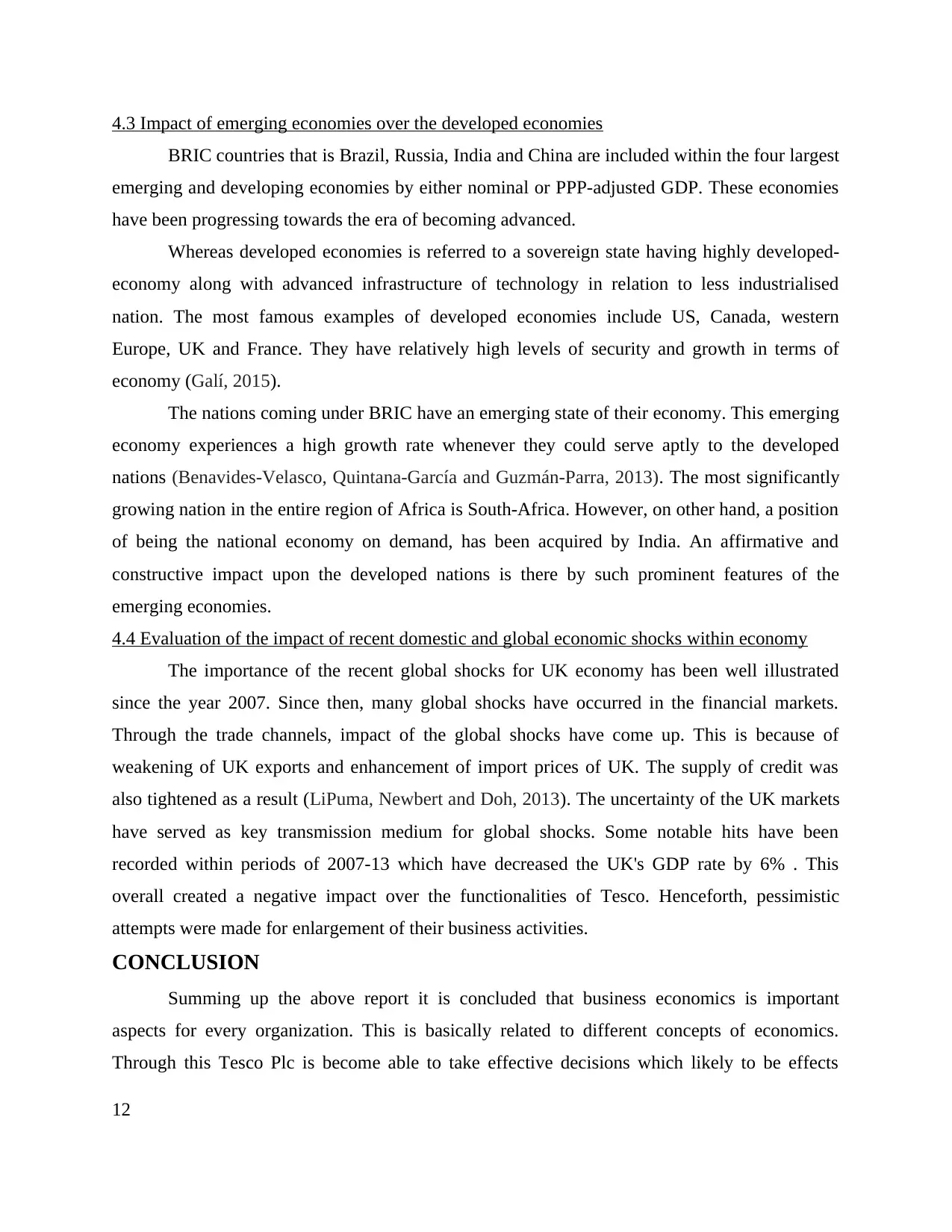
4.3 Impact of emerging economies over the developed economies
BRIC countries that is Brazil, Russia, India and China are included within the four largest
emerging and developing economies by either nominal or PPP-adjusted GDP. These economies
have been progressing towards the era of becoming advanced.
Whereas developed economies is referred to a sovereign state having highly developed-
economy along with advanced infrastructure of technology in relation to less industrialised
nation. The most famous examples of developed economies include US, Canada, western
Europe, UK and France. They have relatively high levels of security and growth in terms of
economy (Galí, 2015).
The nations coming under BRIC have an emerging state of their economy. This emerging
economy experiences a high growth rate whenever they could serve aptly to the developed
nations (Benavides-Velasco, Quintana-García and Guzmán-Parra, 2013). The most significantly
growing nation in the entire region of Africa is South-Africa. However, on other hand, a position
of being the national economy on demand, has been acquired by India. An affirmative and
constructive impact upon the developed nations is there by such prominent features of the
emerging economies.
4.4 Evaluation of the impact of recent domestic and global economic shocks within economy
The importance of the recent global shocks for UK economy has been well illustrated
since the year 2007. Since then, many global shocks have occurred in the financial markets.
Through the trade channels, impact of the global shocks have come up. This is because of
weakening of UK exports and enhancement of import prices of UK. The supply of credit was
also tightened as a result (LiPuma, Newbert and Doh, 2013). The uncertainty of the UK markets
have served as key transmission medium for global shocks. Some notable hits have been
recorded within periods of 2007-13 which have decreased the UK's GDP rate by 6% . This
overall created a negative impact over the functionalities of Tesco. Henceforth, pessimistic
attempts were made for enlargement of their business activities.
CONCLUSION
Summing up the above report it is concluded that business economics is important
aspects for every organization. This is basically related to different concepts of economics.
Through this Tesco Plc is become able to take effective decisions which likely to be effects
12
BRIC countries that is Brazil, Russia, India and China are included within the four largest
emerging and developing economies by either nominal or PPP-adjusted GDP. These economies
have been progressing towards the era of becoming advanced.
Whereas developed economies is referred to a sovereign state having highly developed-
economy along with advanced infrastructure of technology in relation to less industrialised
nation. The most famous examples of developed economies include US, Canada, western
Europe, UK and France. They have relatively high levels of security and growth in terms of
economy (Galí, 2015).
The nations coming under BRIC have an emerging state of their economy. This emerging
economy experiences a high growth rate whenever they could serve aptly to the developed
nations (Benavides-Velasco, Quintana-García and Guzmán-Parra, 2013). The most significantly
growing nation in the entire region of Africa is South-Africa. However, on other hand, a position
of being the national economy on demand, has been acquired by India. An affirmative and
constructive impact upon the developed nations is there by such prominent features of the
emerging economies.
4.4 Evaluation of the impact of recent domestic and global economic shocks within economy
The importance of the recent global shocks for UK economy has been well illustrated
since the year 2007. Since then, many global shocks have occurred in the financial markets.
Through the trade channels, impact of the global shocks have come up. This is because of
weakening of UK exports and enhancement of import prices of UK. The supply of credit was
also tightened as a result (LiPuma, Newbert and Doh, 2013). The uncertainty of the UK markets
have served as key transmission medium for global shocks. Some notable hits have been
recorded within periods of 2007-13 which have decreased the UK's GDP rate by 6% . This
overall created a negative impact over the functionalities of Tesco. Henceforth, pessimistic
attempts were made for enlargement of their business activities.
CONCLUSION
Summing up the above report it is concluded that business economics is important
aspects for every organization. This is basically related to different concepts of economics.
Through this Tesco Plc is become able to take effective decisions which likely to be effects
12
⊘ This is a preview!⊘
Do you want full access?
Subscribe today to unlock all pages.

Trusted by 1+ million students worldwide
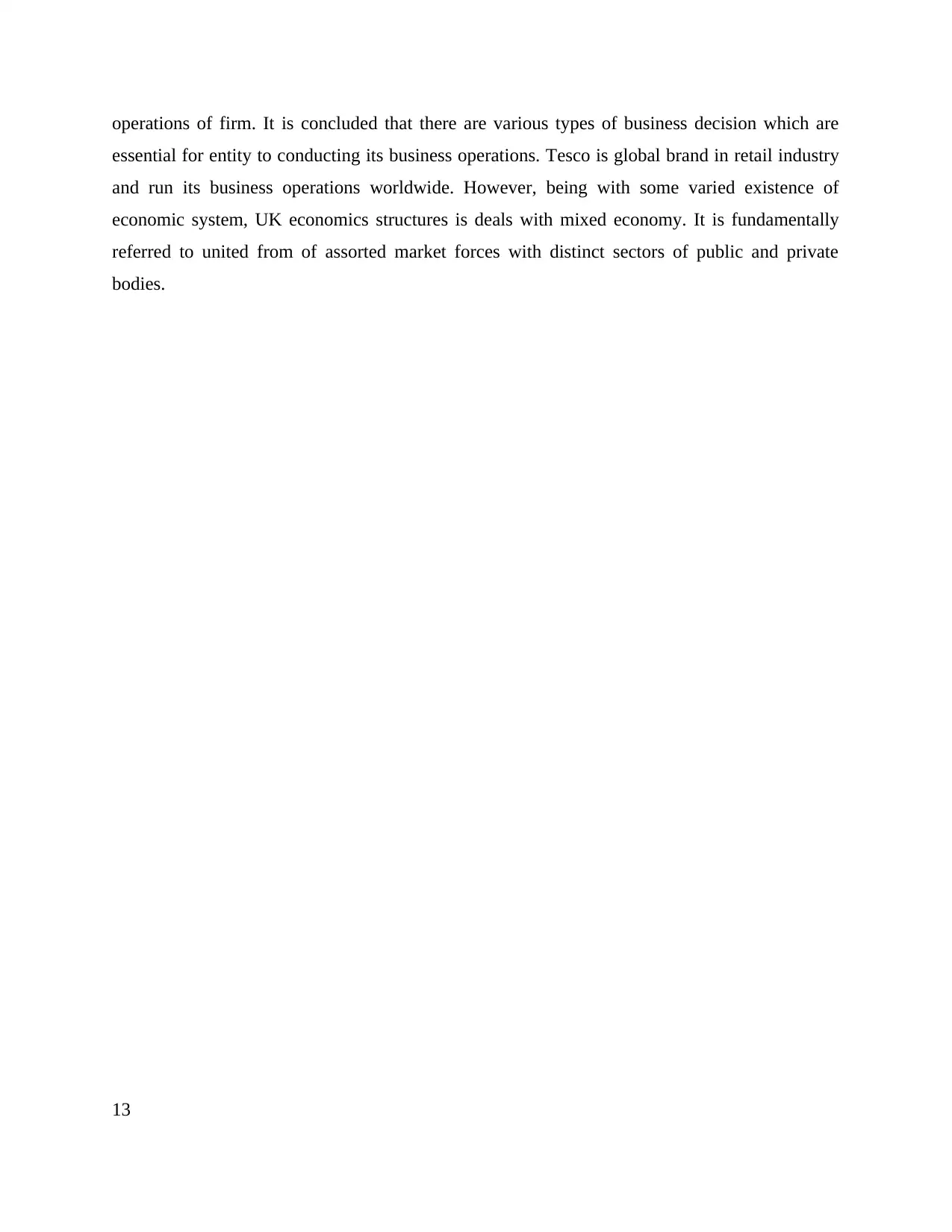
operations of firm. It is concluded that there are various types of business decision which are
essential for entity to conducting its business operations. Tesco is global brand in retail industry
and run its business operations worldwide. However, being with some varied existence of
economic system, UK economics structures is deals with mixed economy. It is fundamentally
referred to united from of assorted market forces with distinct sectors of public and private
bodies.
13
essential for entity to conducting its business operations. Tesco is global brand in retail industry
and run its business operations worldwide. However, being with some varied existence of
economic system, UK economics structures is deals with mixed economy. It is fundamentally
referred to united from of assorted market forces with distinct sectors of public and private
bodies.
13
Paraphrase This Document
Need a fresh take? Get an instant paraphrase of this document with our AI Paraphraser
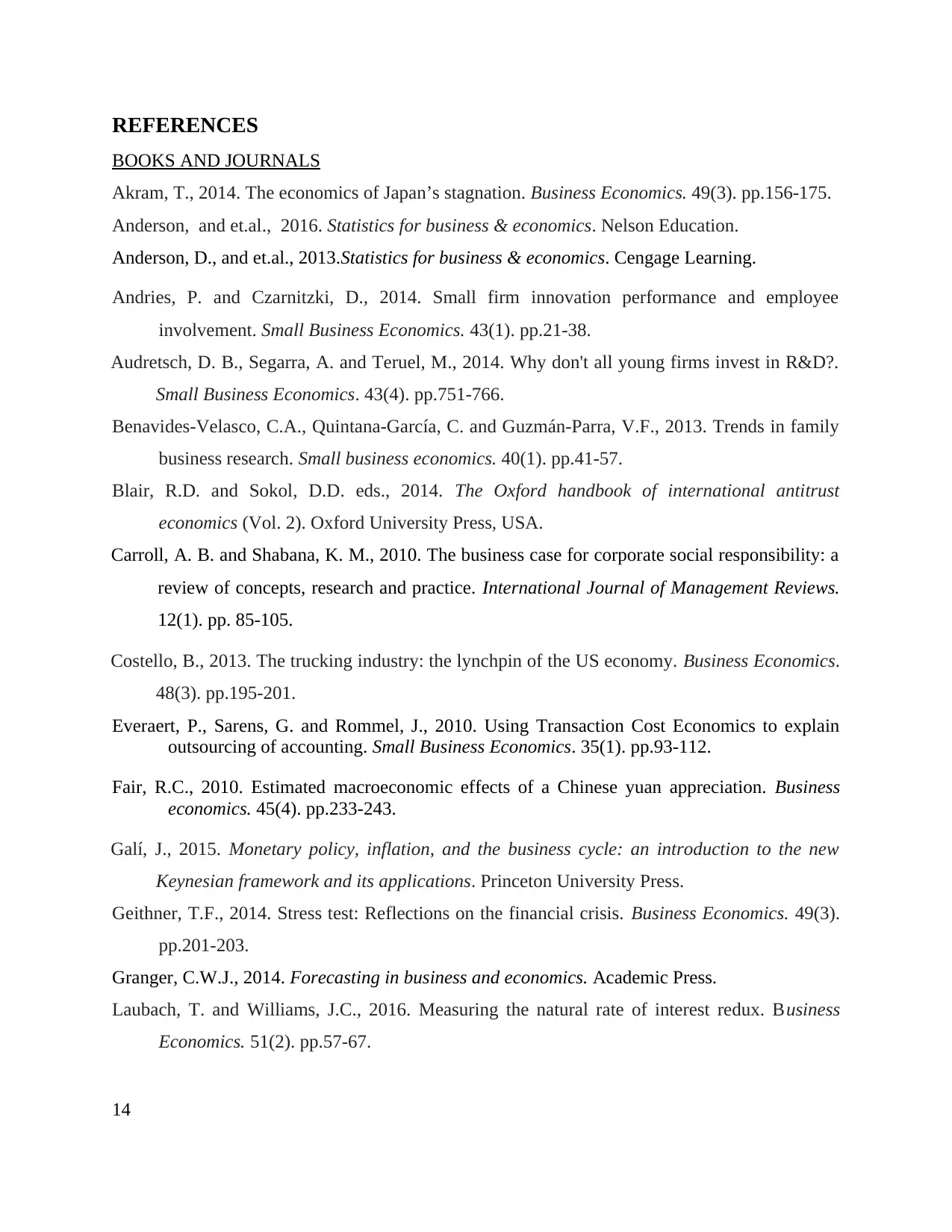
REFERENCES
BOOKS AND JOURNALS
Akram, T., 2014. The economics of Japan’s stagnation. Business Economics. 49(3). pp.156-175.
Anderson, and et.al., 2016. Statistics for business & economics. Nelson Education.
Anderson, D., and et.al., 2013.Statistics for business & economics. Cengage Learning.
Andries, P. and Czarnitzki, D., 2014. Small firm innovation performance and employee
involvement. Small Business Economics. 43(1). pp.21-38.
Audretsch, D. B., Segarra, A. and Teruel, M., 2014. Why don't all young firms invest in R&D?.
Small Business Economics. 43(4). pp.751-766.
Benavides-Velasco, C.A., Quintana-García, C. and Guzmán-Parra, V.F., 2013. Trends in family
business research. Small business economics. 40(1). pp.41-57.
Blair, R.D. and Sokol, D.D. eds., 2014. The Oxford handbook of international antitrust
economics (Vol. 2). Oxford University Press, USA.
Carroll, A. B. and Shabana, K. M., 2010. The business case for corporate social responsibility: a
review of concepts, research and practice. International Journal of Management Reviews.
12(1). pp. 85-105.
Costello, B., 2013. The trucking industry: the lynchpin of the US economy. Business Economics.
48(3). pp.195-201.
Everaert, P., Sarens, G. and Rommel, J., 2010. Using Transaction Cost Economics to explain
outsourcing of accounting. Small Business Economics. 35(1). pp.93-112.
Fair, R.C., 2010. Estimated macroeconomic effects of a Chinese yuan appreciation. Business
economics. 45(4). pp.233-243.
Galí, J., 2015. Monetary policy, inflation, and the business cycle: an introduction to the new
Keynesian framework and its applications. Princeton University Press.
Geithner, T.F., 2014. Stress test: Reflections on the financial crisis. Business Economics. 49(3).
pp.201-203.
Granger, C.W.J., 2014. Forecasting in business and economics. Academic Press.
Laubach, T. and Williams, J.C., 2016. Measuring the natural rate of interest redux. Business
Economics. 51(2). pp.57-67.
14
BOOKS AND JOURNALS
Akram, T., 2014. The economics of Japan’s stagnation. Business Economics. 49(3). pp.156-175.
Anderson, and et.al., 2016. Statistics for business & economics. Nelson Education.
Anderson, D., and et.al., 2013.Statistics for business & economics. Cengage Learning.
Andries, P. and Czarnitzki, D., 2014. Small firm innovation performance and employee
involvement. Small Business Economics. 43(1). pp.21-38.
Audretsch, D. B., Segarra, A. and Teruel, M., 2014. Why don't all young firms invest in R&D?.
Small Business Economics. 43(4). pp.751-766.
Benavides-Velasco, C.A., Quintana-García, C. and Guzmán-Parra, V.F., 2013. Trends in family
business research. Small business economics. 40(1). pp.41-57.
Blair, R.D. and Sokol, D.D. eds., 2014. The Oxford handbook of international antitrust
economics (Vol. 2). Oxford University Press, USA.
Carroll, A. B. and Shabana, K. M., 2010. The business case for corporate social responsibility: a
review of concepts, research and practice. International Journal of Management Reviews.
12(1). pp. 85-105.
Costello, B., 2013. The trucking industry: the lynchpin of the US economy. Business Economics.
48(3). pp.195-201.
Everaert, P., Sarens, G. and Rommel, J., 2010. Using Transaction Cost Economics to explain
outsourcing of accounting. Small Business Economics. 35(1). pp.93-112.
Fair, R.C., 2010. Estimated macroeconomic effects of a Chinese yuan appreciation. Business
economics. 45(4). pp.233-243.
Galí, J., 2015. Monetary policy, inflation, and the business cycle: an introduction to the new
Keynesian framework and its applications. Princeton University Press.
Geithner, T.F., 2014. Stress test: Reflections on the financial crisis. Business Economics. 49(3).
pp.201-203.
Granger, C.W.J., 2014. Forecasting in business and economics. Academic Press.
Laubach, T. and Williams, J.C., 2016. Measuring the natural rate of interest redux. Business
Economics. 51(2). pp.57-67.
14
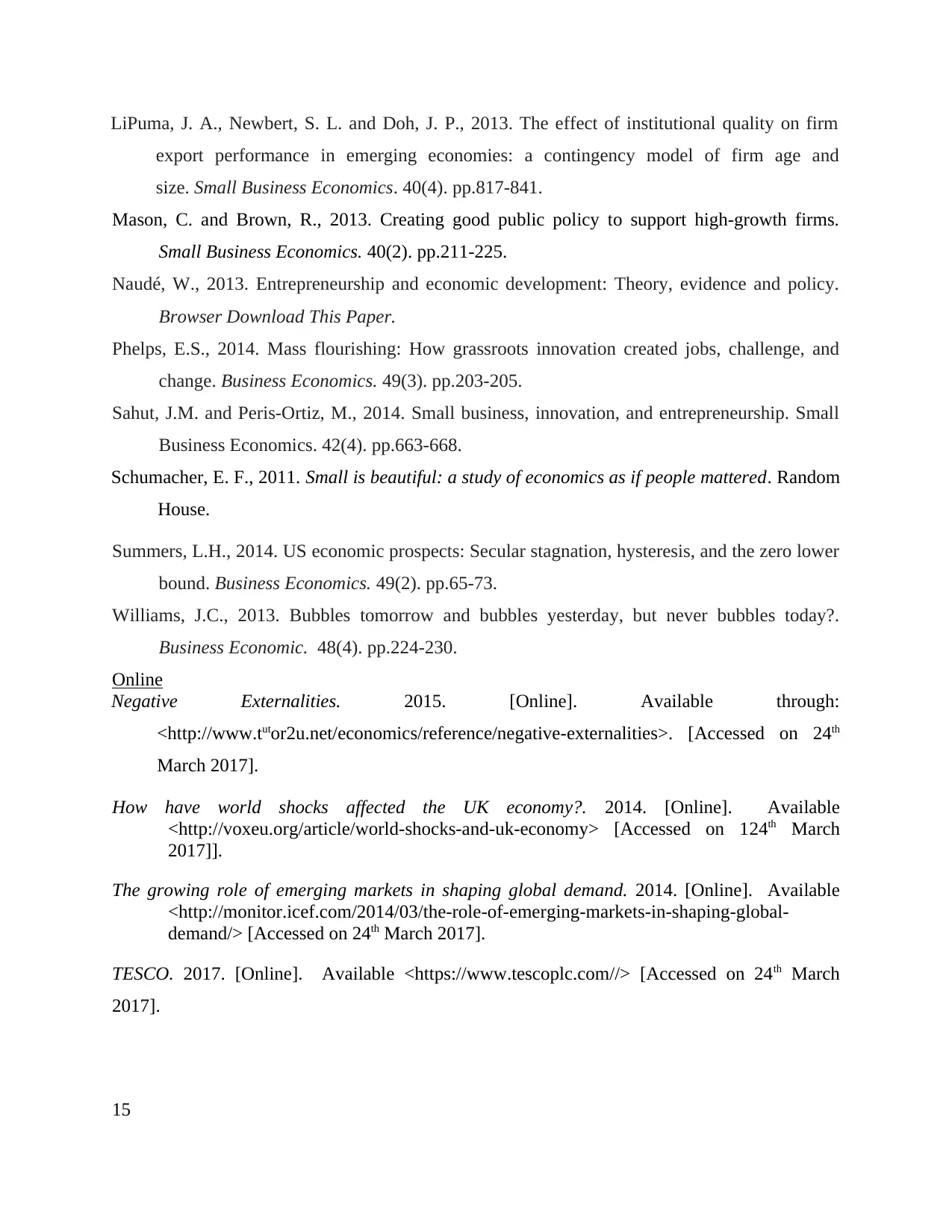
LiPuma, J. A., Newbert, S. L. and Doh, J. P., 2013. The effect of institutional quality on firm
export performance in emerging economies: a contingency model of firm age and
size. Small Business Economics. 40(4). pp.817-841.
Mason, C. and Brown, R., 2013. Creating good public policy to support high-growth firms.
Small Business Economics. 40(2). pp.211-225.
Naudé, W., 2013. Entrepreneurship and economic development: Theory, evidence and policy.
Browser Download This Paper.
Phelps, E.S., 2014. Mass flourishing: How grassroots innovation created jobs, challenge, and
change. Business Economics. 49(3). pp.203-205.
Sahut, J.M. and Peris-Ortiz, M., 2014. Small business, innovation, and entrepreneurship. Small
Business Economics. 42(4). pp.663-668.
Schumacher, E. F., 2011. Small is beautiful: a study of economics as if people mattered. Random
House.
Summers, L.H., 2014. US economic prospects: Secular stagnation, hysteresis, and the zero lower
bound. Business Economics. 49(2). pp.65-73.
Williams, J.C., 2013. Bubbles tomorrow and bubbles yesterday, but never bubbles today?.
Business Economic. 48(4). pp.224-230.
Online
Negative Externalities. 2015. [Online]. Available through:
<http://www.tutor2u.net/economics/reference/negative-externalities>. [Accessed on 24th
March 2017].
How have world shocks affected the UK economy?. 2014. [Online]. Available
<http://voxeu.org/article/world-shocks-and-uk-economy> [Accessed on 124th March
2017]].
The growing role of emerging markets in shaping global demand. 2014. [Online]. Available
<http://monitor.icef.com/2014/03/the-role-of-emerging-markets-in-shaping-global-
demand/> [Accessed on 24th March 2017].
TESCO. 2017. [Online]. Available <https://www.tescoplc.com//> [Accessed on 24th March
2017].
15
export performance in emerging economies: a contingency model of firm age and
size. Small Business Economics. 40(4). pp.817-841.
Mason, C. and Brown, R., 2013. Creating good public policy to support high-growth firms.
Small Business Economics. 40(2). pp.211-225.
Naudé, W., 2013. Entrepreneurship and economic development: Theory, evidence and policy.
Browser Download This Paper.
Phelps, E.S., 2014. Mass flourishing: How grassroots innovation created jobs, challenge, and
change. Business Economics. 49(3). pp.203-205.
Sahut, J.M. and Peris-Ortiz, M., 2014. Small business, innovation, and entrepreneurship. Small
Business Economics. 42(4). pp.663-668.
Schumacher, E. F., 2011. Small is beautiful: a study of economics as if people mattered. Random
House.
Summers, L.H., 2014. US economic prospects: Secular stagnation, hysteresis, and the zero lower
bound. Business Economics. 49(2). pp.65-73.
Williams, J.C., 2013. Bubbles tomorrow and bubbles yesterday, but never bubbles today?.
Business Economic. 48(4). pp.224-230.
Online
Negative Externalities. 2015. [Online]. Available through:
<http://www.tutor2u.net/economics/reference/negative-externalities>. [Accessed on 24th
March 2017].
How have world shocks affected the UK economy?. 2014. [Online]. Available
<http://voxeu.org/article/world-shocks-and-uk-economy> [Accessed on 124th March
2017]].
The growing role of emerging markets in shaping global demand. 2014. [Online]. Available
<http://monitor.icef.com/2014/03/the-role-of-emerging-markets-in-shaping-global-
demand/> [Accessed on 24th March 2017].
TESCO. 2017. [Online]. Available <https://www.tescoplc.com//> [Accessed on 24th March
2017].
15
⊘ This is a preview!⊘
Do you want full access?
Subscribe today to unlock all pages.

Trusted by 1+ million students worldwide
1 out of 15
Related Documents
Your All-in-One AI-Powered Toolkit for Academic Success.
+13062052269
info@desklib.com
Available 24*7 on WhatsApp / Email
![[object Object]](/_next/static/media/star-bottom.7253800d.svg)
Unlock your academic potential
© 2024 | Zucol Services PVT LTD | All rights reserved.





